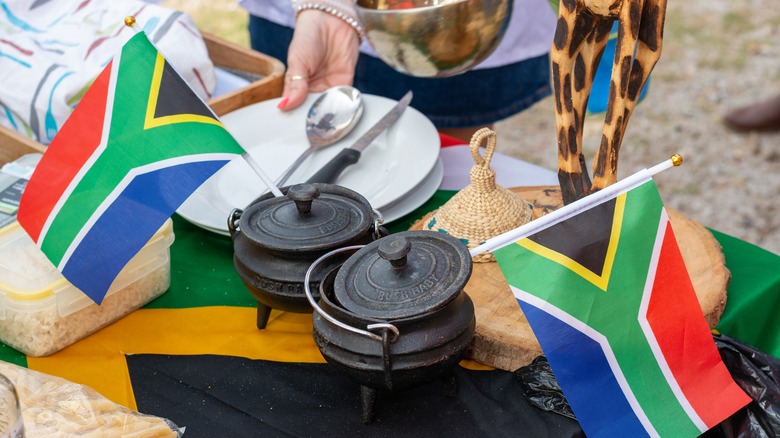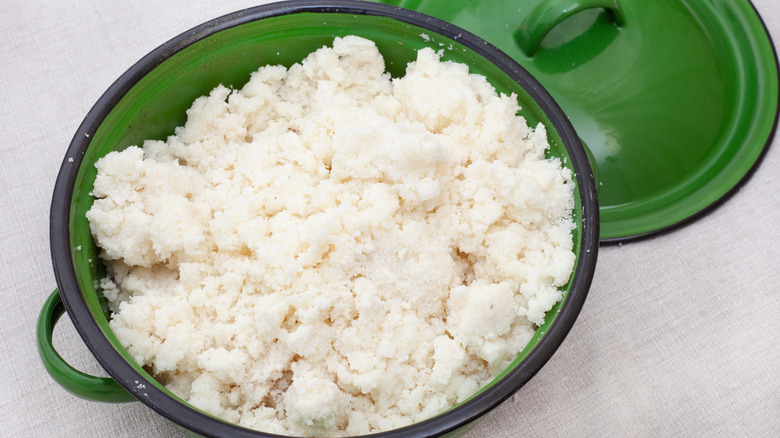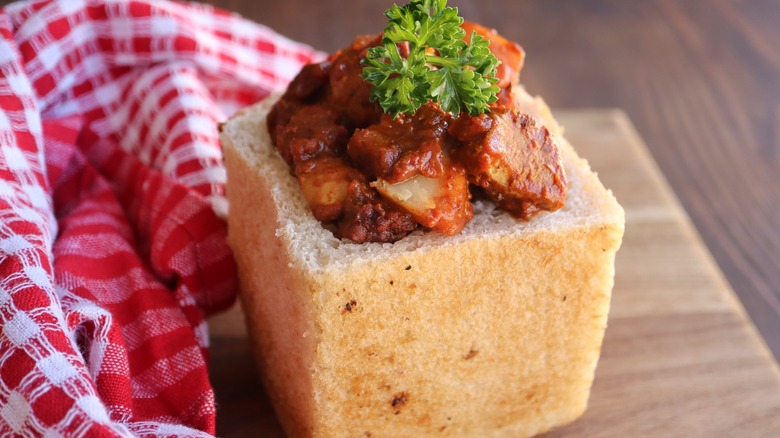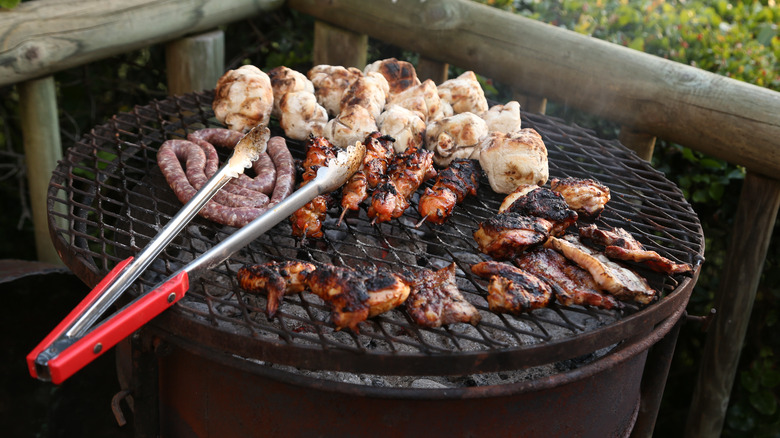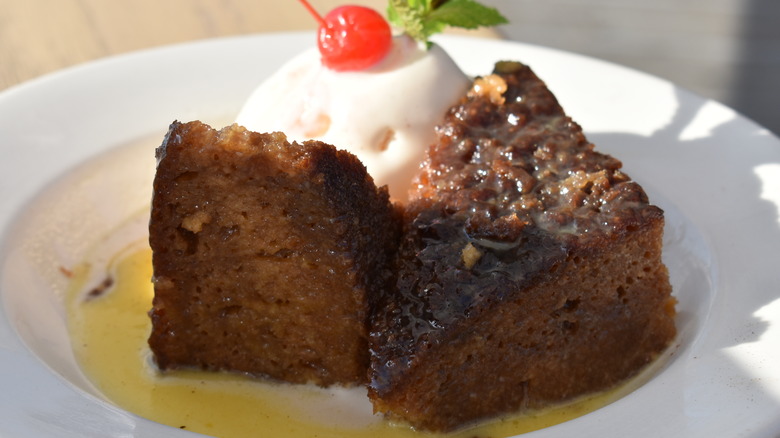The Must-Try Dishes When You're In South Africa
An apt place to start exploring a country is through its food, and South Africa, with its colorful food culture, may be a manifestation of the model reason to do so.
Upon visiting South Africa, you will find the universal bacon and egg breakfasts in ubiquitous diners and restaurants (via Rough Guides), the unmistakable smell of fish and chips wafting from cafes, and the multinational mashups along the main drags (via Daily Maverick and South Africa). However, like any other traditional cuisine, if you wish to experience South African fare, you may need to venture past the cosmopolitan offerings. If you are lucky, your journey will lead you into domestic settings and it is here you will find authentic South African food, albeit with distant nuances of India, The Netherlands, Malaysia, and France, among others, according to South Africa Venues.
As the article in Anthony Bourdain's "Parts Unknown" puts it: "[South Africa's cuisine] reflects the common humanity of its citizenry." "What is significant about South Africa's citizenry?" you may ask. The answer is they are diverse and dynamic, per South African History.
Pap
Corn was first domesticated in central Mexico around 1,500 B.C. According to the Chief Economist of the Agricultural Business Chamber of South Africa (Agbiz), Wandile Sihlobo, it reached Africa around 1,500 A.D.
Since then, this starchy food source has proliferated and become a staple on the continent. In modern times, the African continent consumes 30% of the world's corn produce, states Mordor Intelligence, with South Africa responsible for consuming 5.2 million metric tons of processed corn between 2019 and 2020, per a case study by Roff, a milling equipment producer.
One of the most commonly eaten foods in the country is a corn product called "pap" (pronounced "pup"), says Roff. It is snowy white and adheres to most of the principles of the American Southern-style grits. South Africans manipulate it into different consistencies, with the runnier versions served at breakfast (with sugar) or in its thicker states as part of a savory meal, according to Spoon University, with vegetables and meat stews. On its own, it has a neutral flavor to the point that it may seem tasteless to the Western palate, writes African Bites.
Bunny chow
Durban, on the east coast of South Africa, is considered the birthplace and stronghold of bunny chow, which is a testimony to its high concentration of the naturalized Indian population (per Times Of India, National Public Radio). An additional factor that necessitated the advent of this meal is the Apartheid regime, a segregative reign that once gripped South Africa in its entirety.
"Bunny chow started as a way of selling food to Black people who weren't allowed to eat in certain restaurants during Apartheid," says South African novelist Ameera Patel (via National Public Radio). As the account goes, people of color received their food in hollowed-out bread bowls and, as such, did not need a plate.
Today the hollowed-out bread method is still used, as shown on Youtube, but the only difference is that it takes on an Indian twist when a Durban-style chicken, mutton, fish, or sugar bean curry goes into the bowl, explains Curry Recipe. Bunny chow is known, created, and enjoyed nationwide, but in the same way you would go to Louisiana for the best jambalaya, you should go to Durban for the best bunny chow. Caution: People with low spice tolerances should avoid this altogether.
Braai
"Braai" (pronounced "bry") is a South African word derived from Afrikaans (a spin-off from the vernacular spoken by Dutch settlers) for "grill," "fry," or "roast," but it also describes a version of the barbecue, explains Love Cape Town.
However, heed this fair warning: Never refer to the South African braai as "barbecue." What would have been a lovely cross-cultural social with some meat on the coals is likely to become an hours-long lecture about why it is anything but a barbecue and why it is perhaps better, says Culture Trip.
Although many differences seem like nuances, some rock-solid rules define braaiing:
- The holy grail of the South African braai is that it is always over coals or wood but never gas;
- Traditionally the male host of what is usually a domestic get-together is responsible for this cooking method (via The Savanna);
- You should never try to micromanage or advise him in his endeavors;
- And last, but not least, a true braai cannot transpire without booze — whether it be beer, hardtack, or wine.
Malva pudding
While there are numerous explanations for the existence of malva pudding and its nomenclature, a generally accepted theory is that it is of Dutch origin. The dessert is said to have first landed on South African soil during the 17th century (at the height of the Dutch East India Company era) and was perhaps instrumental in soothing the pangs of homesickness (per Delighted Cooking, The Citizen).
Today, the golden-to-dark-brown, sticky, almost syrupy-sweet cake with nuances of apricot jam (per Bigger Bolder Baking) is accepted as one of South Africa's iconic desserts (via Crush). To reinforce this idea, Nelson Mandela declared the dessert one of his favorites (which was probably the point in the dessert's history when it went from a dish of cultural importance to one of national importance), according to GQ.
The international traveler visiting South Africa will find that malva pudding is served with custard and ice cream and is a common feature on dessert menus, notes Culture Trip.
